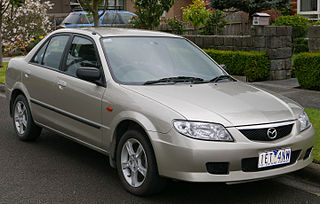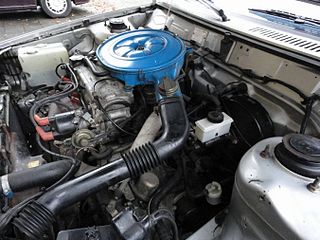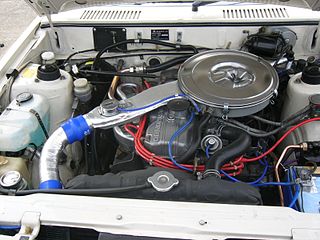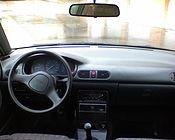
The Ford Laser is a compact car, originally a subcompact car in the first three generations, which was sold by Ford in Asia, Oceania, and parts of South America and Africa. It has generally been available as a sedan or hatchback, although convertible, wagon and pick-up versions have also been available in different markets. The sedan, and briefly station wagon, versions were badged Ford Meteor in Australia between 1982 and 1987. The Ford Meteor name was also used in South Africa.

The Ford Festiva is a subcompact car manufactured by Mazda and marketed by Ford for model years 1986-2002, over three generations in Japan, the Americas, and Australia as the Festiva — and notably, as the Aspire in its North American second generation.

The Mazda Capella, also known as the 626 in Europe, North America and Southeast Asia, is a mid-size car that was manufactured by Mazda from 1970 until 2002. Sold in the Japanese domestic market under the Capella name, the vehicle was also commonly known in other major markets as the Mazda 626. Ford, Mazda's partner at the time, also used the Capella platform to create the Ford Telstar and Ford Probe. 4,345,279 of the 626 and Telstar models were sold worldwide.

The Mazda Familia, also marketed prominently as the Mazda 323, Mazda Protegé and Mazda Allegro, is a small family car that was manufactured by Mazda between 1963 and 2003. The Familia line was replaced by the Mazda3/Axela for 2004.

The Mazda 121 name has been used on a variety of Mazda automobiles for various export markets from 1975 until 2002:

The Mazda Bongo, also known as Mazda E-Series, Eunos Cargo, and the Ford Econovan, is a cabover van and pickup truck manufactured by the Japanese automobile manufacturer Mazda since 1966. The Bongo name was also used for the Bongo Friendee, which is not a cabover design.

The Mazda Demio is a subcompact/supermini/B-segment small car manufactured by Mazda since 1996. While sold across four generations in the domestic Japanese market, the Demio nameplate was rarely used outside of Japan, where it was usually called the Mazda2. The Demio nameplate was retired in 2019 as Mazda changed over to "Mazda2" for their home market as well.

The Ford Cologne V6 is a series of 60° cast iron block V6 engines produced by the Ford Motor Company from 1962 to 2011 in displacements between 1.8 L; 110.6 cu in (1,812 cc) and 4.0 L; 244.6 cu in (4,009 cc). Originally, the Cologne V6 was installed in vehicles intended for Germany and Continental Europe, while the unrelated British Essex V6 was used in cars for the British market. Later, the Cologne V6 largely replaced the Essex V6 for British-market vehicles. These engines were also used in the United States, especially in compact trucks.

The F engine family from Mazda is a mid-sized inline-four piston engine with iron block, alloy head and belt-driven SOHC and DOHC configurations. Introduced in 1983 as the 1.6-litre F6, this engine was found in the Mazda B-Series truck and Mazda G platform models such as Mazda 626/Capella as well as many other models internationally including Mazda Bongo and Ford Freda clone, Mazda B-series based Ford Courier, Mazda 929 HC and the GD platform-based Ford Probe
The Mazda B-series is a small-sized, iron-block, inline four-cylinder engine with belt-driven SOHC and DOHC valvetrain ranging in displacement from 1.1 to 1.8 litres. It was used in a wide variety of applications, from front-wheel drive economy vehicles to the turbocharged full-time 4WD 323 GTX and rear-wheel drive Miata.
The C family was Mazda's first large piston engine design. It is not certain whether Mazda has a name for this collection of engines, and it is uncertain precisely which ones are related.

The iron-block, alloy head E family was an evolution of Mazda's xC design. It was released in June 1980 with the introduction of the first front-wheel drive Mazda Familias and Ford Lasers. Some later variants of the E5-powered Mazda Familia and Ford Laser in Japan incorporated a full-time 4WD drivetrain. All E engines were chain-driven, 8-valve SOHC. Notable features include siamesed cylinders, aluminium rocker arms and pistons, thin block walls, and single valve springs - all in the interest of reducing weight.

Mazda has a long history of building its own diesel engines, with the exception of a few units that were built under license.

The GA engine is a 1.3 to 1.6 L inline-four piston engine from Nissan. It has a cast-iron block and an aluminum head. There are SOHC and DOHC versions, 8, 12, and 16 valve versions, carbureted, single-point, and multi-point injected versions, and versions with variable valve timing (GA16DE). The GA was produced from August 1987 through 2013. Since 1998, it was only available from Mexico in the B13.

The Mitsubishi Astron or 4G5/4D5 engine, is a series of straight-four internal combustion engines first built by Mitsubishi Motors in 1972. Engine displacement ranged from 1.8 to 2.6 litres, making it one of the largest four-cylinder engines of its time.

The E-series was a line of inline four-cylinder automobile engines designed and built by Honda for use in their cars in the 1970s and 1980s. These engines were notable for the use of CVCC technology, introduced in the ED1 engine in the 1975 Civic, which met 1970s emissions standards without using a catalytic converter.

The Ford Sigma is a small straight four automobile engine introduced in 1995 by Ford Motor Company. Its first evolution was sold as the Zetec-S, then Zetec-SE and finally, in later years, renamed Duratec. The last upgrade of the engine is named Duratec Ti-VCT. Conceived for Ford's smaller models, the motor was intended to replace the older HCS and smaller capacity CVH units.

The DLD is the name for an automobile engine family – a group of compact inline-four Diesel engines, involving development by Ford of Britain and/or PSA Group, and also Mazda where it is called the MZ-CD or CiTD. The Ford of Britain/PSA and joint-venture for the production of the DLD/DV was announced in September 1998. Half of the total engine count are produced at Ford of Britain's main plant at Dagenham, England and at Ford's Chennai plant in India, the other half at PSA's Trémery plant in France.

The international or global version of the Ford Ranger is a series of pickup trucks sold by Ford under the Ranger nameplate mainly for markets outside the Americas since 1998. The 1998–2011 international Ranger models were jointly developed with Mazda, sharing the same assembly line and most parts with the Mazda B-Series and its successor, the Mazda BT-50. It is a successor of the Ford Courier as the Mazda-based Ford global pickup. The vehicles are mainly produced in the manufacturing plants in Rayong, Thailand and Pretoria, South Africa.

The Suzuki F engine is a series of inline three- and four-cylinder internal combustion petrol engines manufactured by Suzuki Motor Corporation and also licensed by many manufacturers for their automobiles. This engine was Suzuki's first four-stroke car engine when it first appeared in 1977.
























